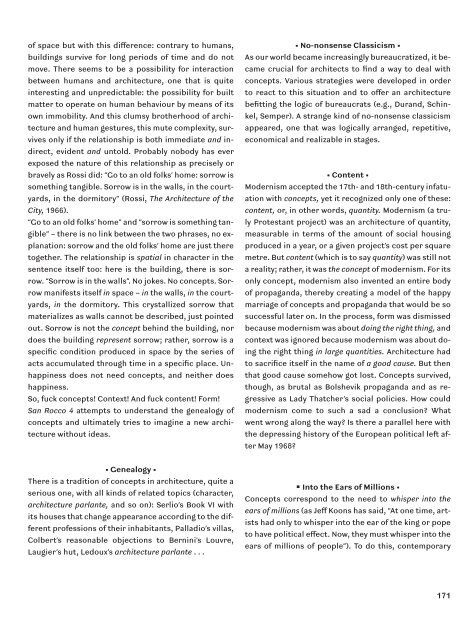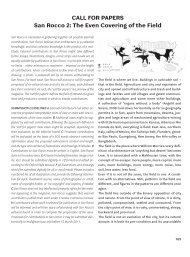CALL FOR PAPERS San Rocco 4: Fuck concepts! Context!
CALL FOR PAPERS San Rocco 4: Fuck concepts! Context!
CALL FOR PAPERS San Rocco 4: Fuck concepts! Context!
- TAGS
- papers
- rocco
- fuck
- sanrocco.info
You also want an ePaper? Increase the reach of your titles
YUMPU automatically turns print PDFs into web optimized ePapers that Google loves.
of space but with this difference: contrary to humans,<br />
buildings survive for long periods of time and do not<br />
move. There seems to be a possibility for interaction<br />
between humans and architecture, one that is quite<br />
interesting and unpredictable: the possibility for built<br />
matter to operate on human behaviour by means of its<br />
own immobility. And this clumsy brotherhood of architecture<br />
and human gestures, this mute complexity, survives<br />
only if the relationship is both immediate and indirect,<br />
evident and untold. Probably nobody has ever<br />
exposed the nature of this relationship as precisely or<br />
bravely as Rossi did: “Go to an old folks’ home: sorrow is<br />
something tangible. Sorrow is in the walls, in the courtyards,<br />
in the dormitory” (Rossi, The Architecture of the<br />
City, 1966).<br />
“Go to an old folks’ home” and “sorrow is something tangible”<br />
– there is no link between the two phrases, no explanation:<br />
sorrow and the old folks’ home are just there<br />
together. The relationship is spatial in character in the<br />
sentence itself too: here is the building, there is sorrow.<br />
“Sorrow is in the walls”. No jokes. No <strong>concepts</strong>. Sorrow<br />
manifests itself in space – in the walls, in the courtyards,<br />
in the dormitory. This crystallized sorrow that<br />
materializes as walls cannot be described, just pointed<br />
out. Sorrow is not the concept behind the building, nor<br />
does the building represent sorrow; rather, sorrow is a<br />
specific condition produced in space by the series of<br />
acts accumulated through time in a specific place. Unhappiness<br />
does not need <strong>concepts</strong>, and neither does<br />
happiness.<br />
So, fuck <strong>concepts</strong>! <strong>Context</strong>! And fuck content! Form!<br />
<strong>San</strong> <strong>Rocco</strong> 4 attempts to understand the genealogy of<br />
<strong>concepts</strong> and ultimately tries to imagine a new architecture<br />
without ideas.<br />
• Genealogy •<br />
There is a tradition of <strong>concepts</strong> in architecture, quite a<br />
serious one, with all kinds of related topics (character,<br />
architecture parlante, and so on): Serlio’s Book VI with<br />
its houses that change appearance according to the different<br />
professions of their inhabitants, Palladio’s villas,<br />
Colbert’s reasonable objections to Bernini’s Louvre,<br />
Laugier’s hut, Ledoux’s architecture parlante . . .<br />
• No-nonsense Classicism •<br />
As our world became increasingly bureaucratized, it became<br />
crucial for architects to find a way to deal with<br />
<strong>concepts</strong>. Various strategies were developed in order<br />
to react to this situation and to offer an architecture<br />
befitting the logic of bureaucrats (e.g., Durand, Schinkel,<br />
Semper). A strange kind of no-nonsense classicism<br />
appeared, one that was logically arranged, repetitive,<br />
economical and realizable in stages.<br />
• Content •<br />
Modernism accepted the 17th- and 18th-century infatuation<br />
with <strong>concepts</strong>, yet it recognized only one of these:<br />
content, or, in other words, quantity. Modernism (a truly<br />
Protestant project) was an architecture of quantity,<br />
measurable in terms of the amount of social housing<br />
produced in a year, or a given project’s cost per square<br />
metre. But content (which is to say quantity) was still not<br />
a reality; rather, it was the concept of modernism. For its<br />
only concept, modernism also invented an entire body<br />
of propaganda, thereby creating a model of the happy<br />
marriage of <strong>concepts</strong> and propaganda that would be so<br />
successful later on. In the process, form was dismissed<br />
because modernism was about doing the right thing, and<br />
context was ignored because modernism was about doing<br />
the right thing in large quantities. Architecture had<br />
to sacrifice itself in the name of a good cause. But then<br />
that good cause somehow got lost. Concepts survived,<br />
though, as brutal as Bolshevik propaganda and as regressive<br />
as Lady Thatcher’s social policies. How could<br />
modernism come to such a sad a conclusion? What<br />
went wrong along the way? Is there a parallel here with<br />
the depressing history of the European political left after<br />
May 1968?<br />
• Into the Ears of Millions •<br />
Concepts correspond to the need to whisper into the<br />
ears of millions (as Jeff Koons has said, “At one time, artists<br />
had only to whisper into the ear of the king or pope<br />
to have political effect. Now, they must whisper into the<br />
ears of millions of people”). To do this, contemporary<br />
171




